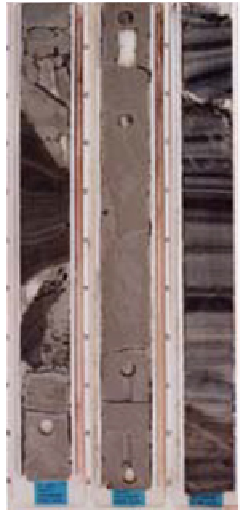Geoscience Reference
In-Depth Information
2080m
Top: 2080
Btm: 2081
Top: 2081
Btm: 2082
Top: 2082
Btm: 2083
Top: 2083
Btm: 2084
Top: 2084
Btm: 2085
2081m
Micro faults
Exotic and
local clasts
2082m
Clast outsizes
width of core
Exotic and
local clasts
Dewatering
sheets
2083m
2084m
Injectite
Well: 25/6-3
To p
:
2085
Btm: 2086
Top: 2086
Btm: 2087
Top: 2087
Btm: 2088
Top: 2088
Btm: 2089
2085m
Silty clay
(levee?)
2086m
Anoxic
black high
-GR clay
Erosion ?
2087m
Massive
sandstone
2088m
Facies
Channel
Splay
Background
2089m
Sand
Fig. 11.
a sedimentological core description of the cores shown in the photographs to the right. The core is from well
25/6-3 and is interpreted to be a vertical representation of the three main depositional elements observed in map view
(Fig. 5). Criteria for distinguishing lateral (levee) and distal (splay fringe) run-outs within the gross 'Background' facies
association have not been established, but the interval with abundant silt laminae represents the most probable levee can-
didate. It is also speculated that the anoxic dark shale capping the massive sandstone facies represents a channel abandon-
ment phase. The dark shale corresponds to a high gamma-ray reading and a similar peak is also found at top of the channel
drilled by well 26/4-2 (Fig. 4). The channel association may therefore be interpreted in a broader context as aggradation
(sand/channel fill), upstream avulsion (black shale/abandonment), formation of a new channel lateral to the first channel
(silty shale/levee) or, alternatively, the levees could be inner levees in a broader channel container (see Fig. 9). The sand-
stone towards the top of the core correlates to the S2 fan retreat phase (see Fig. 4) and has been interpreted as a basal tur-
bidite with overlying debrites. The core width limits the confidence in the interpretation of big clasts. The two deformed
shales around 2082.5 metres have here been interpreted as two similar looking clasts of different size. Note also the injectite
















































































































Search WWH ::

Custom Search